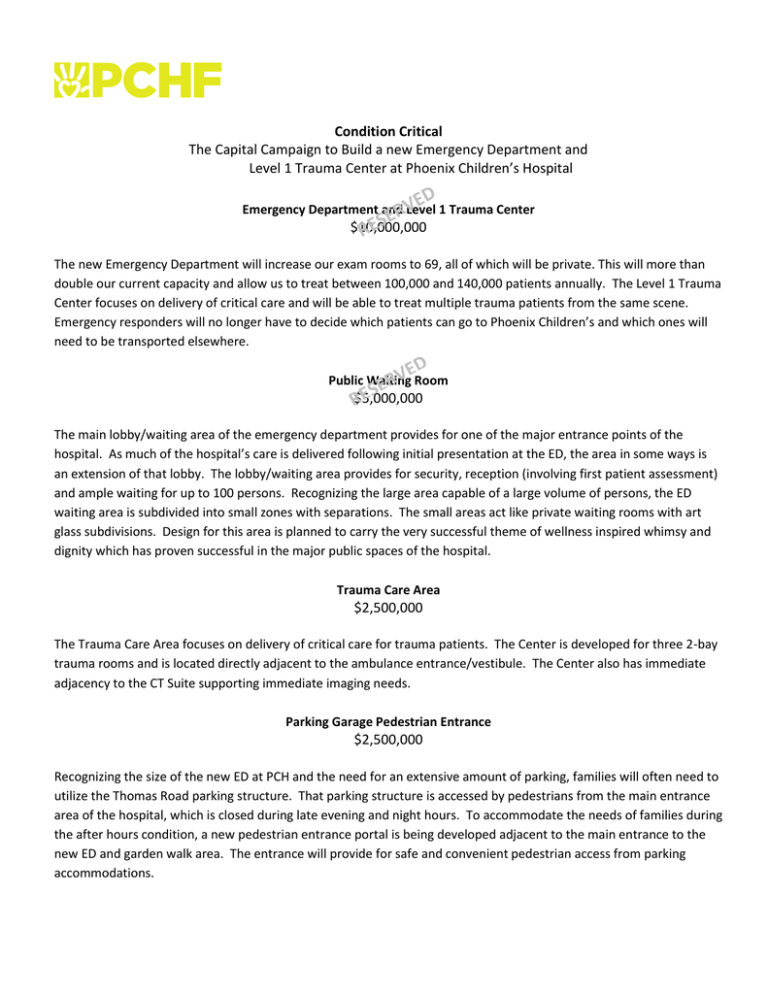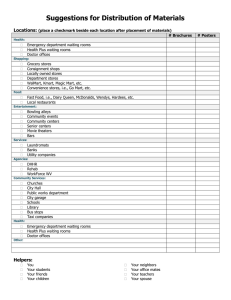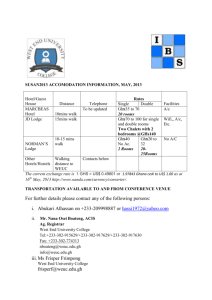Condition Critical The Capital Campaign to Build a new Emergency
advertisement

Condition Critical The Capital Campaign to Build a new Emergency Department and Level 1 Trauma Center at Phoenix Children’s Hospital Emergency Department and Level 1 Trauma Center $10,000,000 The new Emergency Department will increase our exam rooms to 69, all of which will be private. This will more than double our current capacity and allow us to treat between 100,000 and 140,000 patients annually. The Level 1 Trauma Center focuses on delivery of critical care and will be able to treat multiple trauma patients from the same scene. Emergency responders will no longer have to decide which patients can go to Phoenix Children’s and which ones will need to be transported elsewhere. Public Waiting Room $5,000,000 The main lobby/waiting area of the emergency department provides for one of the major entrance points of the hospital. As much of the hospital’s care is delivered following initial presentation at the ED, the area in some ways is an extension of that lobby. The lobby/waiting area provides for security, reception (involving first patient assessment) and ample waiting for up to 100 persons. Recognizing the large area capable of a large volume of persons, the ED waiting area is subdivided into small zones with separations. The small areas act like private waiting rooms with art glass subdivisions. Design for this area is planned to carry the very successful theme of wellness inspired whimsy and dignity which has proven successful in the major public spaces of the hospital. Trauma Care Area $2,500,000 The Trauma Care Area focuses on delivery of critical care for trauma patients. The Center is developed for three 2-bay trauma rooms and is located directly adjacent to the ambulance entrance/vestibule. The Center also has immediate adjacency to the CT Suite supporting immediate imaging needs. Parking Garage Pedestrian Entrance $2,500,000 Recognizing the size of the new ED at PCH and the need for an extensive amount of parking, families will often need to utilize the Thomas Road parking structure. That parking structure is accessed by pedestrians from the main entrance area of the hospital, which is closed during late evening and night hours. To accommodate the needs of families during the after hours condition, a new pedestrian entrance portal is being developed adjacent to the main entrance to the new ED and garden walk area. The entrance will provide for safe and convenient pedestrian access from parking accommodations. Healing Garden $2,500,000 In keeping with the architectural theme Oasis of Healing, the garden will be a beautiful and peaceful representation of calm in the midst of crisis. The abundant and prominent collection of botanicals will be centrally located in the circular drive at the main entrance of the new Emergency and Level 1 Trauma Center. ED Care Area Pod $1,250,000 The Care Area Pods are what truly differentiates the PCH ED. The four pods are established in a linear fashion of 14 and 16 exam rooms surrounding a clinical core. The pods allow for access to exam rooms for patients, parents/families and transport from public corridors at the top and bottom of the pods. The clinical team operates from a core within the center of the exam rooms supporting physicians, nurses and technicians with continuous connection to the exam rooms. This concept eliminates the often found chaos within an ED where all of the traffic and services are provided from one side of the room. Garden Walk $500,000 Just outside the ED Trauma Center, is a unique setting for our visitors to enjoy a private walk or a quiet time of reflection. The Garden Walk is designed for children and families who want a place for privacy, solace and healing. South Ambulance Vestibule $500,000 Supporting the demand of a large emergency center including numbers of people, vehicles and anxiety, a separate ambulance entrance and vestibule is being developed on the south side of the new ED, with a vehicular drive approaching from the intersection of Windsor Drive and 18th Place. The entrance arrival will feature a covered canopy capable of supporting five ambulance vehicles at the same time with access to the ambulance vestibule. Once inside, the vestibule location is located at the center of the department with immediate access to the trauma suites and all examination areas. Triage Care Area $500,000 It is extremely important to ascertain the condition and needs of a person presenting at the ED for care as quickly as possible. When persons arrive, they are first seen is the Triage area for assessment of the medical problem. This is a quick exam to determine severity of the patient’s condition, obtain vitals and first information regarding the matter. This information allows the clinical team to properly locate the patient in the department and initiate the needs of what services will be required. Behavioral Health Care Area $500,000 Supporting the needs of a special care population, the behavioral health care area consists of (6) emergency exam rooms developed in a cluster at the northeast corner of the emergency department. The suite of rooms are located in a private area to minimize confusion with the rest of the ED and are afforded with direct engagement to a clinical service area, which can immediately support the clinical needs of patients and provide direct supervision of these exam rooms. Helipad $500,000 The Emergency Department will be located directly below the helipad and just seconds away from operating rooms, imaging equipment and the Pediatric Intensive Care Unit, reducing transport time and improving care. Helipad Transport Elevator $250,000 The helipad transport elevator exists and was constructed as part of the hospital tower construction. The benefit of the location of the elevator is with construction of the new ED, the elevator is in immediate proximity of the department and especially the Trauma suite. Clinical Staff Work Area $250,000 The four clinical staff work areas located in the center of each of the ED exam pods are self contained units providing for physician, nursing and staff services including work areas, supply storage, medications, equipment space and nutrition. The staff work areas are completely open working environments with complete visual connection to all exam rooms located in the exam pod. The work areas not only provide for direct connection between the staff and patients; the working environment is designed to foster collaboration among the clinical team members. Sub-Waiting Room $250,000 The sub-waiting room provides a resting point for multiple services; The area supports patients who have been triaged and are waiting to be taken to a room, a place for family members to wait while patients are receiving certain examinations and as well as an area for patients awaiting lab results to wait. The waiting room affords convenience to patients and their families while within the main ED for short durations without having to return to the main waiting room. Given that patients are already within the ED, clinical supervision of this interior waiting area is afforded. Conference Room/Training $250,000 The Conference/Training Room is a very important part for the operation of an emergency department. The space located within the clinical department provides for a team work environment for the multiple of persons supporting the ED. The room is especially important as it provides space for in-service education for up to 30 clinical persons at a sitting. In-service for continuing education is a crucial part of daily life in the ED. Given that the service is 24 hours per day/7 days per week, the need is important. EMS Work Room $250,000 The EMS is a much needed space supporting ambulance operations for the ED. The space provides an officing and break space for the technicians serving the hospital. Additionally, a restroom facility and storage room for EMS supplies are provided. Procedure Room $200,000 Planning for the new Emergency Department provides for three Procedure Rooms. These spaces provide a larger accommodation of space than the typical exam rooms and support needs including resuscitation, casting for orthopedics and minor procedures such as insertion of a line in a pediatric patient. CT Room $125,000 The ED CT Suite provides the same type of imaging service as in a radiology department; a more in-depth imaging study than a conventional X-ray. These studies are often required of patients presenting in the ED to quickly determine/diagnose complicated issues, especially for issues related to patients visiting the trauma rooms. Given such, the CT Suite is located within the emergency department and immediately adjacent to the Trauma Rooms for rapid access. Discharge Services $125,000 Discharge Services plays an important role for patients visiting the ED. Discharge including important instructions, follow-up care coordination, any required financial counseling occurs at this point of an ED visit. Having a discharge center removes these concluding matters and provides for an appropriate setting for the more business like portion of the visit. Staff Lounge $125,000 The staff lounge is an extremely vital part for positive operation of an emergency department. ED staff are on-stage for long durations, quite often with extended shifts. A few minutes in the staff lounge represents the only break these clinicians often see. The staff lounge is located slightly away from the main patient zones and affords a respite with view of the outdoors. Staff Locker Room $125,000 Located adjacent to the staff lounge, the staff locker room provides much needed space for staff belongings, changing accommodation and the availability of restroom facilities with a shower. Trauma Bay $125,000 Six trauma bays will allow for the treatment of multiple trauma patients from the same incident. Emergency responders will no longer have to decide which patients can be transported to Phoenix Children’s and which ones need to be taken elsewhere. Exam Room $100,000 The 49 exam rooms are the heart of operations for the emergency department. This is the space that all exams for acute care patients occur. The unique design of the exam rooms for PCH provides for a private patient environment with a clinical sliding glass door connection to the clinical staff core where patients are monitored throughout their stay. The spacious rooms provide for state-of-the-art care with headwall medical gases, LED lighting, supply delivery direct to the room, patient monitoring and dedicated family space within the exam room. There are 63 of these identically planned rooms in the new PCH ED. Exam/Triage Room $100,000 Exam/Triage is the first stop within the ED proper. The series of four exam rooms provide the first level of diagnosis. Patients have their conditions assessed, vital information recorded and determination for level of care and location is provided. Isolation Exam $100,000 There are four isolation exams rooms within the emergency department. These exam spaces are kept for patients with potential infectious conditions. The rooms which appear the same as a traditional exam room are equipped with a negative pressure air system which exhausts all of the air from the rooms and each room is equipped with a private restroom. These rooms are located nearest the entrance and discharge from the department, keeping the potential conditions as removed as possible from the majority of the ED population. Behavioral Exam $100,000 Behavioral Exam Rooms support a special need within the emergency department. The six rooms accommodate patients with potentially behavioral and clinical care needs. As well, depending on availability for post-emergency care, patients may stay in the space for a longer period of time. The exam rooms which are developed as part of a suite in the ED are equipped with the traditional requirements for patient care and have security measures incorporated to ensure patient safety. Family Consult Room $100,000 The family consult room supports multiple needs including private consultation between families and providers, counseling space during difficult situations, a respite space for family members, and a gathering space for families during critical situations. The room is located near to the trauma care area where services are many times required.


